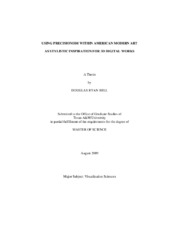| dc.description.abstract | This thesis presents the analysis of artistic techniques of paintings from the Precisionist movement and the implementation of the results of the analysis in the creation of three new works of art using digital media. Artists working in digital media express features of pre-digital artistic movements with varying degrees of adherence to principles, intentions, and awareness. This thesis seeks to create a bridge between the recognition of common features of Precisionist works and the expression of those elements in new works through the use of a system of analysis, interpretation, and translation. One outcome of this thesis is the description of a methodology for interpretation and translation that can be applied to other art movements.
The Precisionist period within the Modern Art movement has both a historical importance in the world of art and a thematic relevance to popular uses of digital media ? specifically the representation of meaning and mood derived from industrial settings. Its influences can be traced from cubist, futurist, and constructivist art, as well as influencing the development of surrealism. It is considered the first solely American movement within Modern Art. Charles Sheeler's work plays a key role in the visual analysis portion of this research. Sheeler's work offers examples for applying 2D precisionist artistic style as aesthetic inspiration in creating a three-part production of 3D digital and video work. Work from precisionist artists Charles Demuth and Edmund Lewandowski also contribute some unique artistic characteristics considered during the analytical portion of this study. The new artistic works proposed include: (1) a linear, live-action short video with post-production manipulation; (2) a linear, 3D animated work; and (3) a non-linear, interactive 3D game environment. | en |


